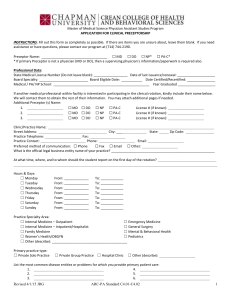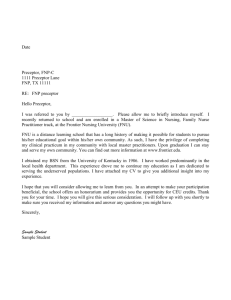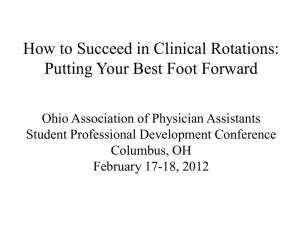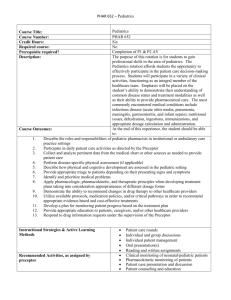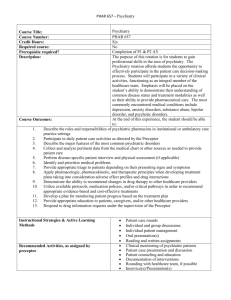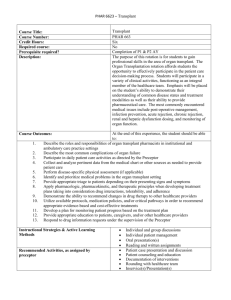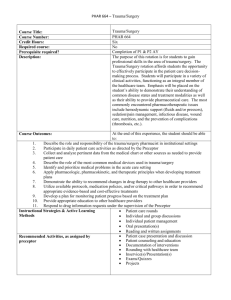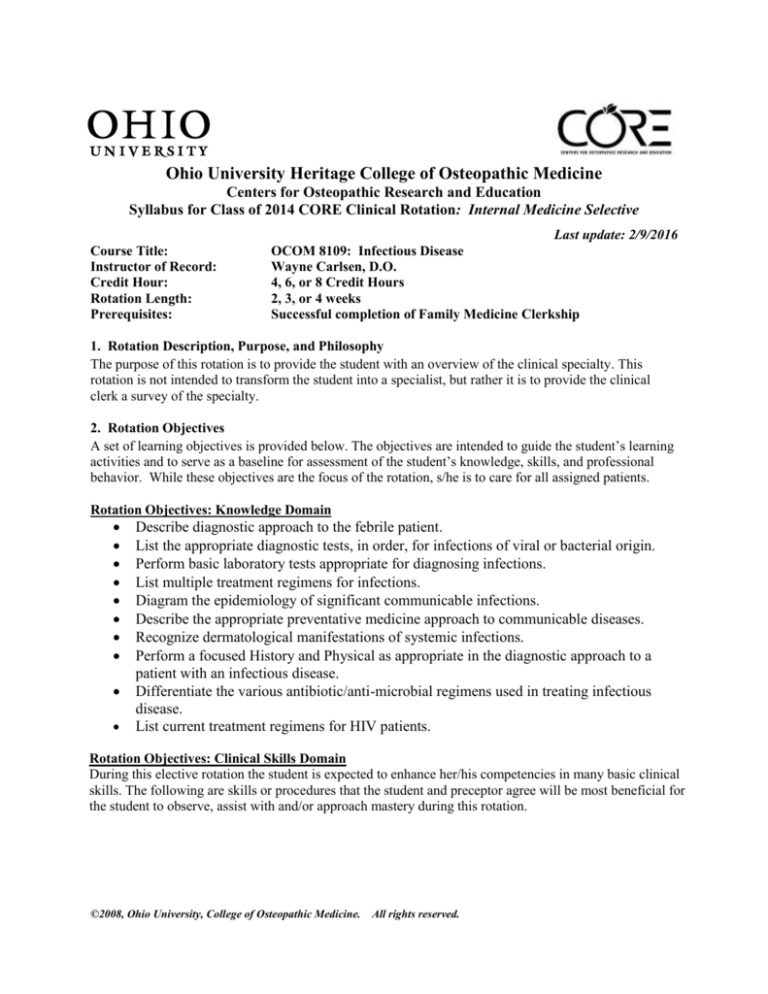
Ohio University Heritage College of Osteopathic Medicine
Centers for Osteopathic Research and Education
Syllabus for Class of 2014 CORE Clinical Rotation: Internal Medicine Selective
Course Title:
Instructor of Record:
Credit Hour:
Rotation Length:
Prerequisites:
Last update: 2/9/2016
OCOM 8109: Infectious Disease
Wayne Carlsen, D.O.
4, 6, or 8 Credit Hours
2, 3, or 4 weeks
Successful completion of Family Medicine Clerkship
1. Rotation Description, Purpose, and Philosophy
The purpose of this rotation is to provide the student with an overview of the clinical specialty. This
rotation is not intended to transform the student into a specialist, but rather it is to provide the clinical
clerk a survey of the specialty.
2. Rotation Objectives
A set of learning objectives is provided below. The objectives are intended to guide the student’s learning
activities and to serve as a baseline for assessment of the student’s knowledge, skills, and professional
behavior. While these objectives are the focus of the rotation, s/he is to care for all assigned patients.
Rotation Objectives: Knowledge Domain
Describe diagnostic approach to the febrile patient.
List the appropriate diagnostic tests, in order, for infections of viral or bacterial origin.
Perform basic laboratory tests appropriate for diagnosing infections.
List multiple treatment regimens for infections.
Diagram the epidemiology of significant communicable infections.
Describe the appropriate preventative medicine approach to communicable diseases.
Recognize dermatological manifestations of systemic infections.
Perform a focused History and Physical as appropriate in the diagnostic approach to a
patient with an infectious disease.
Differentiate the various antibiotic/anti-microbial regimens used in treating infectious
disease.
List current treatment regimens for HIV patients.
Rotation Objectives: Clinical Skills Domain
During this elective rotation the student is expected to enhance her/his competencies in many basic clinical
skills. The following are skills or procedures that the student and preceptor agree will be most beneficial for
the student to observe, assist with and/or approach mastery during this rotation.
©2008, Ohio University, College of Osteopathic Medicine. All rights reserved.
Internal Medicine Selective: Infectious Disease
Chest x-rays / computerized tomography (CT) scans / magnetic resonance imagery (MRI) scans
Complete blood count (CBC), Immunological status
Urine, cerebrospinal fluid (CSF) analysis
Lumbar puncture
Culture and sensitivity (C & S) of nose, throat, urethra, anus
Culture and sensitivity (C & S) of abscess
Microscopic analysis of skin scraping
Stool analysis for ova/parasites
Antibiotic sensitivity testing
3. Orientation to the Rotation
The student should try to meet with the preceptor either prior to or on the first day of the rotation. Clarifying
the following details with the preceptor will help to ensure a rewarding and successful rotation:
a. Student responsibilities on the service.
b. Preceptor expectations of the student on the service.
c. Goals, objectives, and the structure of the rotation.
d. Required rotation assignments and responsibilities in the preceptor’s practice (e.g. clinics, lectures,
conferences, other didactics, journal clubs, rounds, office hours, morning report).
e. Discuss the Evaluation of Student Clinical Performance form. The student should ask for feedback
several times during the rotation, especially at mid-rotation. In addition, he/she should be prepared to share
past clinical experiences and personal objectives for this rotation with the preceptor.
4. Required Learning Activities, Assignments, and Responsibilities
In order to earn academic credit for this rotation, the following activities must be completed successfully:
a.
Fulfill all required responsibilities identified by the preceptor during orientation.
b.
Attend and participate in all CORE education day and other didactic presentations as described in the
Year 3and 4 Student Manual and as assigned by the CORE Assistant Dean.
c.
Within two weeks of the end of the rotation,
Submit the online Student Evaluations of both preceptor and rotation through E*Value.
Submit to the CORE office via E*Value a 1-2 page summary specifically describing how the
student met the established objectives as stated in this syllabus. (This evaluation activity will
serve as an alternative to the standard post-rotation exam.)
Ensure that your preceptor’s written evaluation is completed and submitted to the CORE office.
Submit Procedures Log through E*Value. Each student will maintain a log of procedures s/he
has performed or observed, using E*Value software program. The software program will
automatically generate an email to the preceptor, asking that s/he acknowledge the student’s
participation in performing the procedure. If the preceptor agrees with the log as submitted, no
further effort on the student’s part will be required. If the preceptor indicates the log is
inaccurate, the student will need to modify and resubmit the log per the preceptor’s request.
5. Student Performance Evaluation
A student’s grade for this rotation will be based on completion of all assignments and the following criteria.
The Preceptor’s Written Evaluation
A student must receive a passing grade from the preceptor in order to pass the rotation. If the preceptor
considers the student’s progress to be Marginal, the Committee on Student Progress will recommend an
appropriate remediation plan. If the preceptor grades the student progress as Failure, the student will be given a
grade of “F” for the rotation and will be referred to the Committee on Student Progress (CSP).
Acceptance of Summary
The CORE Assistant Dean will review the summary paper to determine whether or not the report of how the
student met the objectives is acceptable; questionable papers will be forwarded by individual CORE Assistant
©2008, Ohio University, College of Osteopathic Medicine. All rights reserved.
Internal Medicine Selective: Infectious Disease
Deans to the Instructor of Record (the Interim Associate Dean Clinical Education) for final review and
determination.
6. Recommended Resources
1. Mandell GL, Douglas RG, Bennett JE, eds. Principles and Practice of Infectious Diseases.
6th ed. Philadelphia, PA: Elsevier Churchill Livingstone, 2005.
2. www.CDC.gov
See the Class of 2013 Year 3 and 4 Student Manual booklist for a list of resources approved for ALL
rotations.
7. Standards of Professional Conduct
The OU-HCOM Honor Code applies to all activities in the CORE as well as on the Athens campus. “As a
member of the medical profession, I will maintain the highest standards of academic and personal behavior.
As a medical student I will not cheat or plagiarize or tolerate that behavior in others.” OU-HCOM Honor
Code
Students are encouraged to study together and to share their knowledge freely with one another during the
learning process. During examinations, however, no assistance from other students or from outside sources
is allowed, unless explicitly permitted by the CORE office. Books, notes, and other materials must be left at
the periphery of the testing area during examinations.
Professional standards required of a member of the Osteopathic profession are a requirement for passing this
rotation, as is compliance with the professional standards of the hospital and outpatient offices of the
student’s preceptor. Students are expected to maintain high professional standards of behaviors. They
should exhibit such personal characteristics as honesty and integrity, as well as to maintain patient
confidentiality at all times. Unprofessional behavior may result in a failing grade in this rotation, regardless
of other academic performance on this rotation, and could subject the student to dismissal from the hospital
in which they are based. Professional conduct shall be evaluated by the CORE Assistant Dean through
observation of and interaction with the student, his/her preceptor, other hospital attending physicians and
staff.
8. Tips for Successfully Completing the Rotation
Success on this rotation requires the student to be proactive. Taking an interest in the specialty and becoming
an active team member of the service is critical to learning in a clinical setting. Remember, the clinical
learning environment differs from the classroom. The student will be expected to think on his/her feet and
learn as s/he goes. To capitalize on the learning moment, seek out opportunities to ask questions and speak
up appropriately.
In addition, be sure to:
review the syllabus to understand all requirements
discuss with the preceptor previous clinical experiences and personal goals and objectives for this
rotation
clarify the preceptor’s expectations of performance early on in the clerkship
come prepared to take advantage of the opportunities this rotation has to offer
If there are any questions, please contact the CORE Administrator or CORE Assistant Dean.
©2008, Ohio University, College of Osteopathic Medicine. All rights reserved.

